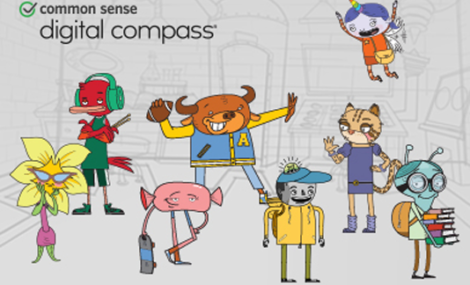Digital Citizenship Lesson Plan: Digital Compass

This lesson plan, adaptable for grades 3-12, features the innovative game Digital Compass, in which players explore how decisions they make in their digital lives affect other aspects of their lives. Through a choose-your-own-path format, students play through the perspective of one of eight main characters, each of whom is facing a different digital citizenship dilemma, from cyberbullying to relationships and communication. The varied story paths and multiple decision points encourage students to play repeatedly in order to explore alternative courses of action.
Students will:
- Find facts and gather data for conscientious decisions.
- Synthesize information and evaluate options.
- Assess situations in order to make informed judgments.
- Reflect on decisions and determine alternative choices.
- Build interpersonal empathy by role-playing and taking the perspective of others.
- Develop skill-based competencies through game-based learning.
- Apply learnings to real-world situations.
Materials:
- Computers or other devices with Internet access
- Interactive whiteboard
Preparation:
This lesson plan features a choose-your-own-path game called Digital Compass, developed by our partner Common Sense Education. The game invites students to step into the shoes of a character who is experiencing the twists and turns of daily digital life, challenging them to make decisions and try out possible solutions to various real-world dilemmas.
Preview the Digital Compass Introduction Video and play the game to plan how you will adapt it to your students’ needs. If students will be working in small groups, review tips on Setting Cooperative Gaming Expectations. Review the Educator Guide for a summary of each of the eight digital dilemma stories, assessment, research on the game design, and reflective writing prompts. See the Quick Start Guide for how to get started and best practices for implementation and ease of use.
For ideas on how to use SnapThought with this game, read Digital Compass: SnapThought Prompts for more information and specific SnapThought prompts to provide students during game play.
Build background knowledge or reinforce topics with these BrainPOP movies: Digital Etiquette, Cyberbullying, Social Networking, Online Safety, Information Privacy, Email and IM, Conflict Resolution, Internet, Blogs, Ethics, Bullying, Stress, Peer Pressure, and Adolescence.
Lesson Procedure:
- Begin the lesson by asking students what they think when they hear the words “digital citizenship.” Write their responses on the whiteboard. Once everyone has had a chance to respond, share Common Sense Education’s definition of digital citizenship: “the ability to be a safe, responsible and respectful citizen online.” Now ask the class why being a digital citizen is so important today, or more specifically what kind of issues kids are dealing with today that require being a digital citizen. Some answers may include cyberbullying, digital cheating, and internet safety.
- Display Digital Compass on the whiteboard. Play the introduction for the whole class. When the introduction ends, explain to students that in small groups they will play through the perspective of one of eight main characters, each of whom is facing a different digital citizenship dilemma. As a group they will work together to make decisions about what actions their character should take.
- Divide the class into groups of three or four and assign each group a character/story. Have the group watch a BrainPOP movie(s) associated with their topic as follows:
Digital Compass Story BrainPOP Movie Hack-a-wrong Ethics Digital Heartbreak Cyberbullying; Adolescence Break it Down Online Safety Insta-slammed Social Networking Me, Me, Meme Digital Etiquette Citation Infestation Ethics; Stress Sticky Situation Information Privacy Kung Fu Fibber Ethics; Peer Pressure - Then have the group go through the story together. As they come to each decision point, encourage them to consider the options, weighing the pros and cons of each. If students have individual logins through My BrainPOP, encourage them to use the SnapThought® tool to take snapshots while they’re making their decisions. Review Digital Compass: SnapThought Prompts for suggested prompts.
- Circulate the classroom as students are working. Listen to their conversations. As needed, encourage them to listen to each other and make sure that every student in a group is participating by sharing his or her opinion about what decision to make in the story.
- After all the groups have completed their stories, bring the class together. Have each group present to the class. Have one student in the group summarize the story; another student or two can share some of the decisions they made, including an example of what they agreed upon and where they disagreed. They can use the whiteboard to share some of their SnapThoughts. Finally, have another student describe the end result of their decision making.
- You may repeat this lesson on another day, keeping the same groups, but assigning different stories. They can compare and contrast the decision they make with the group that had previously played the same story.
Extension Activities:
Reflective Writing Prompts. Choose one or more of the Reflective Writing Prompts on page 8 of the Digital Compass Educator Guide. You may decide to give the same prompts to the whole class and compare and contrast their responses. Or, you can assign different prompts to different students. You may use the Reflective Writing Rubric on page 9 to assess students’ responses.The More You Know, the More You Know ®











